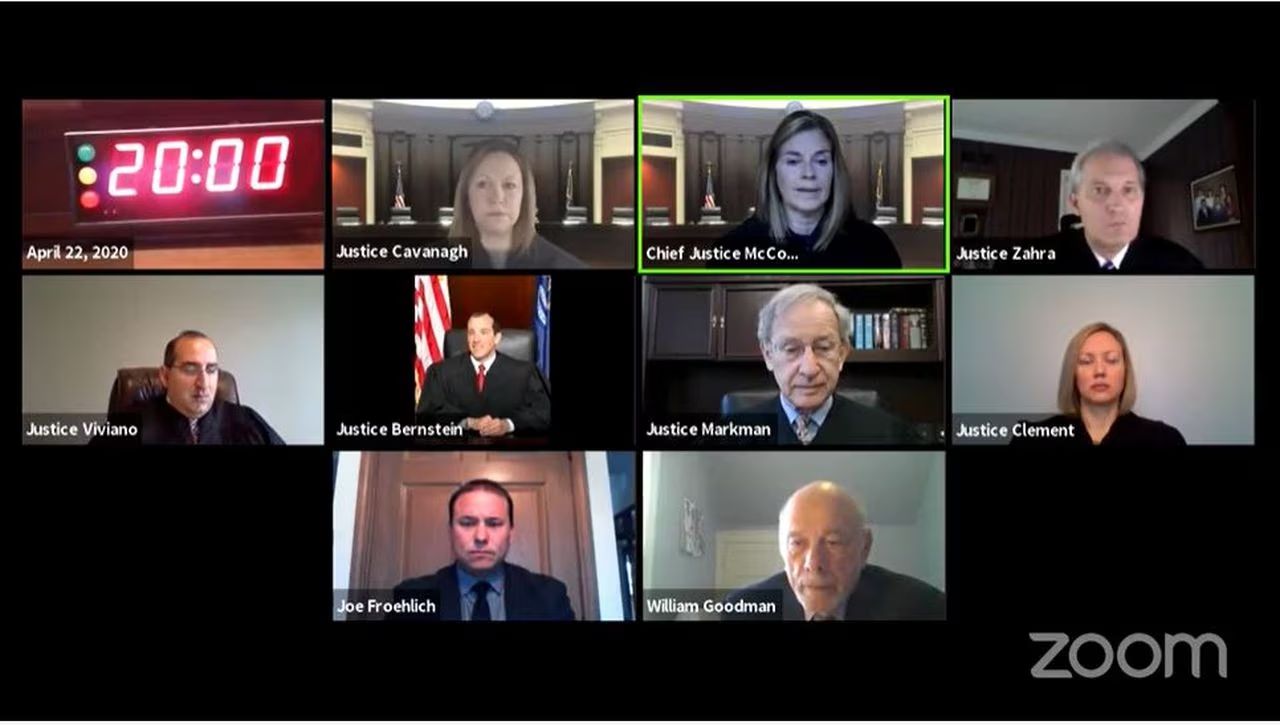Introduction
Welcome to the age of technology, where the traditional courtroom is slowly being replaced by virtual courtrooms. With the advent of video conferencing platforms like Zoom, court hearings can now take place remotely, allowing for greater convenience and accessibility. But how long does a Zoom court hearing typically last? This is a common question for those who find themselves involved in legal proceedings.
In this article, we will explore the duration of Zoom court hearings, understanding the factors that affect their length, and providing tips for efficient and effective virtual courtroom proceedings. Whether you’re a lawyer, a litigant, or simply curious about the judicial process, this article will give you valuable insights into the time frame of Zoom court hearings.
Zoom court hearings have gained significant popularity in recent times, especially with the COVID-19 pandemic forcing courts to adapt to remote proceedings. This technological advancement has allowed attorneys, judges, and parties to participate in court hearings from the comfort of their own homes or offices, eliminating the need for physical attendance.
Understanding the dynamics of Zoom court hearings is essential for anyone involved in the legal process. By understanding the factors that contribute to the length of these virtual court proceedings, participants can better prepare and manage their time accordingly. Additionally, gaining insights into the average duration of Zoom court hearings can help set realistic expectations and reduce the element of uncertainty that often accompanies legal proceedings.
Whether you’re a plaintiff or defendant, a witness, or a legal professional, it is crucial to have a solid understanding of the duration of a Zoom court hearing. This knowledge will enable you to allocate the necessary time and resources required for effective participation. So, let’s dive into the world of Zoom court hearings and discover how long they typically last.
Understanding Zoom Court Hearings
Zoom court hearings are an innovative solution that allows legal proceedings to be conducted remotely through the use of video conferencing technology. Participants, including judges, attorneys, witnesses, and parties to the case, can join the virtual courtroom from any location with an internet connection.
One of the key advantages of Zoom court hearings is the ability to save time and resources. Traditionally, attending a court hearing would require individuals to travel to a physical courtroom, potentially resulting in significant delays and associated costs. With Zoom, participants can attend court hearings from the comfort of their own office or home, eliminating the need for travel expenses and reducing the time commitment involved.
Virtual courtrooms operate in a similar way to physical courtrooms. Legal arguments, testimonies, and evidence presentations can be made through video and audio communication, with participants following the same procedures as they would in a traditional court setting.
Zoom court hearings offer a range of features that facilitate effective communication and collaboration. Participants can share screens to present documents or evidence, utilize real-time chat functions to communicate with each other, and even record the proceedings for future reference.
While virtual court hearings may lack the ambiance and formality of a physical courtroom, they provide an efficient and practical way to conduct legal proceedings. The convenience and accessibility of Zoom court hearings have become even more prominent during the global pandemic, as they provide a solution to gather parties involved in a case while maintaining social distancing measures.
It is essential to note that despite the advantages of Zoom court hearings, there are still some limitations. Technical issues can arise, such as internet connection problems, audio or video disruptions, or difficulty sharing large and complex documents. However, with proper preparation and troubleshooting procedures in place, these issues can be minimized, ensuring a smooth and efficient virtual courtroom experience.
By understanding the fundamentals of Zoom court hearings, participants can adapt to this digital approach to justice and make the most of the convenience and efficiency it offers. In the next section, we will explore the factors that can influence the duration of a Zoom court hearing.
Factors Affecting the Duration of a Zoom Court Hearing
The duration of a Zoom court hearing can vary depending on several factors. Understanding these factors can help participants better manage their time and expectations. Here are some key elements that can influence the duration of a Zoom court hearing:
- Complexity of the case: The complexity of the legal matter being discussed is often a significant factor in determining the duration of a court hearing. Cases that involve intricate legal issues, numerous parties, or extensive evidence may require more time for arguments, examination of witnesses, and discussions among the parties involved.
- Number of participants: The number of participants in a Zoom court hearing can impact its duration. With more parties involved, there may be more opportunities for discussions, objections, and questions, which can extend the overall length of the proceeding.
- Preparation and organization: Adequate preparation and organization by all parties involved can help streamline the court hearing process. Well-prepared attorneys and witnesses who present their arguments and testimonies concisely and effectively can help expedite the proceedings.
- Technological issues: As with any technology, technical issues can arise during a Zoom court hearing. Internet connection problems, audio or video disruptions, or difficulties with screen sharing can cause delays and interruptions that impact the duration of the hearing. It is essential for all participants to have a stable internet connection and troubleshoot any technical issues beforehand to minimize disruptions.
- Judicial discretion: The judge presiding over the Zoom court hearing has the authority to manage the proceedings and allocate time to each party. The judge’s management style and decision-making can affect the duration of the hearing, as they may allow for more or less time for arguments, presentations, and discussions based on their judgment.
It is important to note that while these factors can influence the duration of a Zoom court hearing, each case is unique, and the actual length of the hearing may vary. Some cases may be resolved quickly, while others may require multiple sessions or extended time for deliberation.
By being aware of these factors, participants can make appropriate preparations and manage their time effectively to ensure an efficient and productive Zoom court hearing experience. In the following sections, we will explore the average duration of Zoom court hearings, as well as provide insights into both short and long hearings.
Average Duration of a Zoom Court Hearing
The duration of a Zoom court hearing can vary significantly depending on the complexity of the case and other factors mentioned earlier. However, it is helpful to have a general understanding of the average duration of these virtual court proceedings.
On average, a Zoom court hearing can last anywhere from 15 minutes to several hours. Simple and straightforward matters, such as procedural hearings or uncontested motions, may be resolved within a short time frame. Conversely, more complex cases involving extensive arguments, witness examinations, or multiple parties may require several hours, or even multiple sessions, to reach a resolution. The specific time frame of a Zoom court hearing is ultimately at the discretion of the judge presiding over the case.
It is important to recognize that the transition to virtual courtrooms may have influenced the length of court hearings. The increased convenience and accessibility of Zoom hearings have allowed for more efficient scheduling and reduced the need for unnecessary travel time. As a result, some hearings that would have required a full day or more in a physical courtroom can now be completed in a shorter time frame in the virtual setting.
Furthermore, the use of video conferencing technology may contribute to more focused and streamlined discussions. Participants are often more mindful of time constraints and may present their arguments or testimonies more succinctly, leading to a more efficient hearing process.
It is vital for participants to allocate an appropriate amount of time for a Zoom court hearing, taking into account the specific details of their case and the factors that may affect its duration. Proper preparation and organization can help minimize any unnecessary delays and ensure that the hearing proceeds smoothly.
While the average duration of a Zoom court hearing provides a general guideline, it is essential to remember that each case is unique and may require more or less time based on its particular circumstances. The judge and parties involved should communicate effectively to manage time expectations and ensure that sufficient time is allocated for a fair and thorough proceeding.
In the next sections, we will explore both short and long Zoom court hearings, providing insights into their possible durations and considerations for effective participation.
Short Zoom Court Hearings
In some cases, Zoom court hearings can be completed relatively quickly. These short hearings typically involve matters that are straightforward, uncontested, or require minimal discussion or evidence. While the exact duration may vary, short Zoom court hearings are often resolved within 15 to 30 minutes.
Examples of short Zoom court hearings include procedural matters, such as scheduling conferences or status conferences, where the primary purpose is to set future dates and discuss administrative details related to the case. In these instances, the judge may simply confirm the agreed-upon dates and address any procedural questions raised by the parties. As these hearings generally do not require extensive arguments or examination of witnesses, they tend to be relatively brief.
Similarly, uncontested motions or stipulated orders can also be addressed in short Zoom court hearings. These are situations where both parties agree on the requested relief or the terms of an agreement. The judge may review the motion or stipulation, ask clarifying questions if needed, and promptly issue an order or ruling.
It is important for participants in short Zoom court hearings to come prepared with concise and clearly articulated arguments. By presenting their case efficiently and sticking to the key points, attorneys can help expedite the process. Additionally, sharing relevant documents or exhibits ahead of the hearing can further streamline the proceedings.
However, it is crucial to note that the brevity of a Zoom court hearing does not diminish its importance. Even in short hearings, participants must demonstrate professionalism and respect for the judicial process. Parties should be attentive, responsive, and prepared to address any issues that may arise during the hearing.
By understanding the nature of short Zoom court hearings and their potential duration, participants can effectively allocate their time and resources and make the most of these streamlined proceedings.
In the following section, we will explore the flip side of the spectrum and discuss longer Zoom court hearings that may require more extensive time commitments.
Long Zoom Court Hearings
While some Zoom court hearings are brief and straightforward, others can span hours or even multiple sessions. Long Zoom court hearings typically involve complex legal issues, contested matters, or cases with significant amounts of evidence or multiple parties.
Examples of long Zoom court hearings include trials, evidentiary hearings, or hearings involving extensive witness examinations. In these proceedings, attorneys may present detailed arguments, present evidence, cross-examine witnesses, and engage in extensive discussions with the opposing party. The length of these hearings can vary greatly depending on the complexity of the case and the number of issues that need to be addressed.
Witness examinations, in particular, can significantly contribute to the length of a Zoom court hearing. Cross-examination of witnesses by opposing counsels can be time-consuming, especially when dealing with experts or individuals with extensive knowledge of the case. Thoroughly examining witnesses while ensuring a fair opportunity for all parties to present their case is crucial, but it can also extend the overall duration of the hearing.
Additionally, in lengthy Zoom court hearings, judges may allocate time for lengthy oral arguments, allowing attorneys to fully present their case and address any legal nuances. These extended arguments serve to ensure that all parties have the opportunity to thoroughly argue their positions, thereby promoting fairness and justice.
Long Zoom court hearings require careful time management and organization from all participants. Attorneys should be prepared with well-structured arguments and clear presentation of evidence. Judges may establish time limits for each party’s presentation to maintain order and avoid unnecessary delays. Prioritizing key issues, utilizing technology effectively, and maintaining focus can help streamline the proceedings and prevent unnecessary prolongation of the hearing.
Parties involved in long Zoom court hearings should also be aware of the potential fatigue and strain associated with extended virtual proceedings. Maintaining concentration and actively participating throughout the hearing is essential, even as the hours go by. Taking appropriate breaks and practicing self-care during longer hearings can help participants stay engaged and alert.
It is important to recognize that the length of a Zoom court hearing, whether short or long, is ultimately determined by the judge presiding over the case. Their management of the proceedings, including time allocation and control over the presentation of evidence and arguments, significantly influences the overall duration.
By understanding the nature of long Zoom court hearings and the factors that may contribute to their duration, participants can adequately prepare and plan for the time commitment required, ensuring a smooth and efficient virtual courtroom experience.
In the next section, we will provide tips for efficient Zoom court hearings, regardless of their duration.
Tips for Efficient Zoom Court Hearings
Participating in a Zoom court hearing requires effective preparation, organization, and adaptability. Whether the hearing is short or long, implementing these tips can help ensure an efficient and productive virtual courtroom experience:
- Test your technology: Before the hearing, test your internet connection, audio, and video quality. Make sure you have a stable connection and troubleshoot any technical issues that may arise. Familiarize yourself with the features of the video conferencing platform, such as screen sharing and chat functions.
- Be prepared: Thoroughly review and organize your case materials, including documents, exhibits, and witnesses’ testimonies. Anticipate potential arguments or objections and be ready to address them. Prepare concise and well-structured arguments to present your case effectively.
- Follow courtroom etiquette: Treat the Zoom court hearing with the same level of professionalism as you would a physical courtroom. Dress appropriately, maintain a neutral and respectful demeanor, and avoid distractions. Adhere to the judge’s instructions and wait for your turn to speak.
- Manage your time: Be mindful of time constraints and stay focused on the relevant issues at hand. Avoid unnecessary repetition or going off-topic. Stay within the time limits set by the judge and prioritize the key points of your argument.
- Utilize visual aids: Use screen sharing to present documents, exhibits, or visuals that support your case. Ensure that the visuals are clear and easy to read for all participants. Sharing relevant visuals can enhance the understanding of your arguments and save time by avoiding lengthy explanations.
- Engage in active listening: Pay close attention to the proceedings and actively listen to other participants, including the judge and opposing counsel. Take notes and be prepared to respond or ask relevant questions when appropriate. Active listening demonstrates professionalism and helps facilitate the flow of the hearing.
- Maintain professional conduct: Avoid distractions, such as checking emails or engaging in side conversations, during the hearing. Treat all participants with respect and professionalism, even if there are disagreements. Remember that the virtual setting does not diminish the importance of courtroom decorum.
- Be adaptable: While technological issues are rare, be prepared for unexpected disruptions and remain calm if they occur. Have alternative methods of communication ready, such as a phone line, to ensure that the hearing can proceed smoothly. Cooperate with any troubleshooting attempts made by the court staff or IT support.
By following these tips, participants can navigate Zoom court hearings with efficiency and professionalism. Adequate preparation, effective time management, and respectful conduct contribute to a fair and productive virtual courtroom experience.
Remember, each Zoom court hearing is unique, and the judge’s discretion plays a significant role. Strive to be flexible and adaptable to ensure a smooth and successful virtual courtroom experience.
In the next section, we will conclude this article by summarizing the key points discussed and highlighting the importance of effective participation in Zoom court hearings.
Conclusion
As virtual courtrooms become increasingly prevalent, understanding the duration and dynamics of Zoom court hearings is vital for participants in the legal process. These virtual proceedings offer convenience and accessibility, allowing parties to attend hearings from anywhere with an internet connection.
In this article, we explored the various aspects of Zoom court hearings, including factors that can affect their duration, the average length of these hearings, and tips for efficient participation.
Factors such as the complexity of the case, number of participants, preparation, technological issues, and judicial discretion can all influence the length of a Zoom court hearing. By being aware of these factors, participants can better manage their time and resources, ensuring a smooth and productive hearing experience.
The average duration of a Zoom court hearing can range from 15 minutes to several hours, depending on the nature of the case. Short hearings, involving procedural matters or uncontested motions, can be resolved relatively quickly, while longer hearings, such as trials or evidentiary hearings, may require more extensive time commitments.
To make the most of Zoom court hearings, participants should follow tips for efficiency and professionalism. Testing technology beforehand, being prepared, following courtroom etiquette, managing time effectively, utilizing visual aids, engaging in active listening, maintaining professional conduct, and being adaptable can all contribute to a successful virtual courtroom experience.
In conclusion, the transition to Zoom court hearings provides a convenient and accessible alternative to traditional courtrooms. By understanding the duration factors, average length, and adopting effective participation strategies, participants can navigate the virtual courtroom with confidence and facilitate the efficient administration of justice.

























